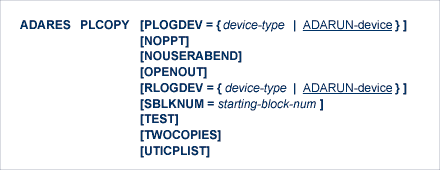The PLCOPY function is used only if dual/multiple logging of protection information was specified for the Adabas session. This function copies the data set that has the earlier time stamp to a sequential data set. Once the PLCOPY function is successfully completed, the copied data set is marked as empty. This function may, therefore, be used only once in an Adabas session for any given data set.
The use of hardware compression (IDRC) is not recommended for protection log files. The ADARES BACKOUT function is not supported for hardware-compressed data on VSE and z/VM systems. On z/OS systems, the BACKOUT function will take at least twice as long to run when processing compressed data.
The PLCOPY function is not allowed in single-user mode.

The PLCOPY function has special uses if you are using the Adabas Delta Save Facility. Refer to the Adabas Delta Save Facility documentation for more information.
ADARES PLCOPY can be specified with no parameters.
This document covers the following topics:
PLOGDEV specifies the device type used for dual/multiple protection log data sets. This parameter is required if the device type used for the dual/multiple protection log data set is different from that specified with the ADARUN DEVICE parameter.
The parallel participant table (PPT) tells ADARES PLCOPY which data sets to copy. If the PPT is destroyed, the ADARES NOPPT function allows the DBA to specify the PLOG data sets that are to be copied and merged.
If ADARAI is used, the PLOG data sets are written to the RLOG at nucleus initialization. In the event of a failure and a final PLCOPY is still needed, ADARAI can construct the PLCOPY NOPPT JCL from the PLOG data sets written to the RLOG.
NOPPT is intended only for emergency use when the PPT has been overwritten. It specifies that the PPT is to be ignored and DD/PLOG data sets are to be supplied with JCL.
| Warning: Use this parameter cautiously since it ignores the PPT and all control-type information typically provided by the PPT. |
When you use this parameter, you must supply
the correct intermediate data set; and
the correct input protection logs from all nuclei in the form of DD/PLOG01-nn.
| Warning: Without the PPT, ADARES cannot perform any extensive validations on the input data sets. |
When an error is encountered while the function is running, the utility prints an error message and terminates with user abend 34 (with a dump) or user abend 35 (without a dump).
If NOUSERABEND is specified, the utility will not abend after printing the error message. Instead, the message "utility TERMINATED DUE TO ERROR CONDITION" is displayed and the utility terminates with condition code 20.
The OPENOUT parameter indicates that the DD/SIAUS1/2 output data sets are to be opened by ADARES, even if no data is actually to be copied. Without OPENOUT, the sequential output data sets are not opened if ADARES detects an end-of-file condition while attempting to read the first input record; this may cause problems in some operating system environments. With OPENOUT, the output data sets are opened before the first input record is read.
The RLOGDEV parameter is used if the Adabas Recovery Aid (ADARAI) is active to specify a device-type for the recovery log (RLOG) data set.
If RLOGDEV is not specified (the default), the recovery log device type is assumed to be the same as the ADARUN DEVICE parameter.
If the specified or default value for RLOGDEV is incorrect, ADARES PLCOPY terminates with error 149, "missing or mismatching RLOGDEV parameter".
The RLOGDEV parameter makes it possible for ADARES to record its function for ADARAI, even if the GCBs of the database have been destroyed.
The SBLKNUM parameter can only be specified in conjunction with the NOPPT parameter and only for the PLCOPY function.
SBLKNUM allows the user to specify the starting block number for the sequential merge output. If this parameter is omitted, an attempt will be made to read the PPT and obtain the block number from there. If this read fails, the output will start with block one.
To determine the value for this parameter, the user must look at the output from the previous PLCOPY and use the next block number in sequence.
The TEST parameter tests the operation syntax without actually performing the operation. Only the syntax of the specified parameters can be tested; not the validity of values and variables.
TWOCOPIES causes two copies of the output to be created. If TWOCOPIES is not specified, the default is one copy.
The UTICPLIST parameter causes ADARES to select and print all SYNP, SYNV, and SYNS checkpoints found on the data protection log during the PLCOPY function.
Copy the dual/multiple protection log.
ADARES PLCOPY
Create two copies of the dual/multiple protection log.
ADARES PLCOPY TWOCOPIES
Copy the dual/multiple protection log. The Adabas Recovery Aid (ADARAI) is active. The recovery log (RLOG) device type is 8390.
ADARES PLCOPY RLOGDEV=8390